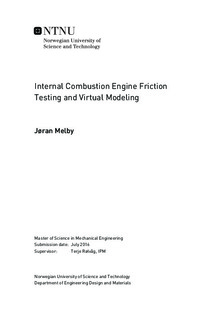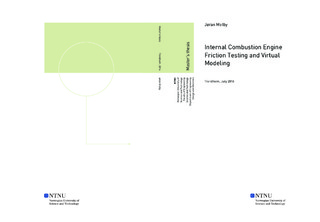| dc.description.abstract | A virtual test bench capable of performing integrity analysis of internal engine components
has previously been developed in FEDEM. It does however not include
any damping and friction effects. As a result, engine performance is overestimated
and shows little dependency on the inertia and mass of engine components. In this
thesis, the friction and damping effects related to the piston assembly, connecting
rod, and crankshaft of an engine were identified. A customized engine test rig was
designed, and motored testing performed from 3000 rpm to 9000 rpm to measure
the friction torque of a partial assembly of a Honda CRF 250 R engine. A virtual
test bench representing the physical testing was developed and tuned in FEDEM.
Problems were encountered with a damaged torque transducer, possibly affecting
the accuracy of the measurements, and resulting in less experimental data than
desired. Engine oil was found to squeeze past the piston rings as a consequence
of testing without cylinder pressure, possibly affecting lubrication conditions. Test
results showed that the dominating piston assembly lubrication regime changes from
boundary, via mixed, to hydrodynamic with increasing engine speed. This caused
the measured friction torque to go from 1 Nm (3000 rpm), via a peak of 1.6 Nm (5000
rpm), to 1.5 Nm (9000 rpm). The engine friction s sensitivity to oil temperature
was noted. Engine friction and oil shearing produced enough heat to keep the oil
temperature at 87 °C at 4000 rpm, exemplifying the need for cooling systems, even
in motored testing. Measurements taken before and after engine break-in clearly
showed the importance of break-in on the engine s friction losses.
The virtual test bench was successfully able to recreate the measurements from
physical engine testing. Simulation with reduced connecting rod mass did not produce
the expected friction reduction, and it was suspected that a weakness in the
modeling approach was responsible. The friction modeling formulation in FEDEM
did not have the capability to capture the changes in lubrication regime for the
piston assembly. It did not support a variable coefficient of friction, but required
the Coulomb coefficient to have a constant value. Compensating for this weakness
by adding additional viscous damping resulted in a less realistic model behavior.
It is concluded that more test data and improved friction modeling in FEDEM is required
to obtain a virtual test bench accurate enough to predict real engine behavior,
when inertia and mass properties of critical engine components are changed. | |

